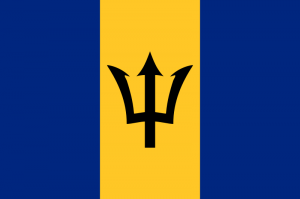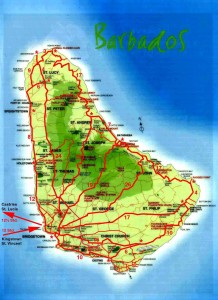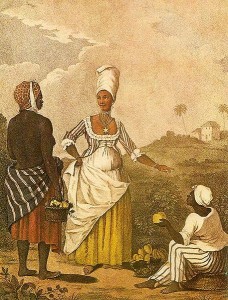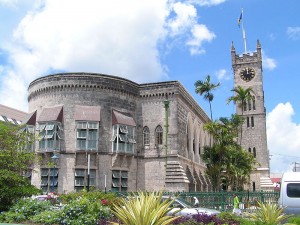Barbados

History of Barbados
Barbados (![]() i/bɑrˈbeɪdɒs/ or /bɑrˈbeɪdoʊs/) is a sovereign island country in the Lesser Antilles. It is 34 kilometres (21 mi) in length and up to 23 kilometres (14 mi) in width, covering an area of 432 square kilometres (167 sq mi). It is situated in the western area of the North Atlantic and 100 kilometres (62 mi) east of the Windward Islands and the Caribbean Sea; therein, it is about 168 kilometres (104 mi) east of the islands of Saint Vincent and the Grenadines and 400 kilometres (250 mi) north-east of Trinidad and Tobago. Barbados is outside of the principal Atlantic hurricane belt.
i/bɑrˈbeɪdɒs/ or /bɑrˈbeɪdoʊs/) is a sovereign island country in the Lesser Antilles. It is 34 kilometres (21 mi) in length and up to 23 kilometres (14 mi) in width, covering an area of 432 square kilometres (167 sq mi). It is situated in the western area of the North Atlantic and 100 kilometres (62 mi) east of the Windward Islands and the Caribbean Sea; therein, it is about 168 kilometres (104 mi) east of the islands of Saint Vincent and the Grenadines and 400 kilometres (250 mi) north-east of Trinidad and Tobago. Barbados is outside of the principal Atlantic hurricane belt.
Barbados was discovered by Spanish navigators in the late 15th century and claimed for the Spanish Crown. It first appears on a Spanish map from 1511. The Portuguese visited the island in 1536, but they left it unclaimed, with their only remnants being an introduction of wild hogs for a good supply of meat whenever the island was visited. The first English ship, the Olive Blossom, arrived in Barbados in 1624. They took possession of it in the name of King James I. In 1627 the first permanent settlers arrived from England, and it became an English and later British colony.
Barbados has a population of 277,821 people, In 1966, Barbados became an independent state and Commonwealth realm, retaining Queen Elizabeth II as Head of State. Barbados is one of the Caribbean’s leading tourist destinations and is one of the most developed islands in the region, despite it actually being classed as an Atlantic Island, with an HDI number of 0.825. In 2011 Barbados ranked second in the Americas (16th globally) on Transparency International‘s Corruption Perception Index, behind Canada.
Etymology
 The origin of the name Barbados is either the Portuguese word Barbados or theSpanish equivalent Barbudos, both meaning “the bearded ones”. It is unclear whether “bearded” refers to the long, hanging roots of the bearded fig-tree (Ficus citrifolia), indigenous to the island; or to the allegedly bearded Caribs once inhabiting the island; or, more fancifully, to the foam spraying over the outlying reefs giving the impression of a beard. In 1519, a map produced by the Genoese mapmaker Visconte Maggiolo showed and named Barbados in its correct position. Furthermore, an island in theLeewards that is very close in name is Barbuda and was once named Las Barbudas by the Spanish.
The origin of the name Barbados is either the Portuguese word Barbados or theSpanish equivalent Barbudos, both meaning “the bearded ones”. It is unclear whether “bearded” refers to the long, hanging roots of the bearded fig-tree (Ficus citrifolia), indigenous to the island; or to the allegedly bearded Caribs once inhabiting the island; or, more fancifully, to the foam spraying over the outlying reefs giving the impression of a beard. In 1519, a map produced by the Genoese mapmaker Visconte Maggiolo showed and named Barbados in its correct position. Furthermore, an island in theLeewards that is very close in name is Barbuda and was once named Las Barbudas by the Spanish.
The uncertainty lies in which European nation arrived first in Barbados. According to some sources it was the Spanish during the early Voyages of Christopher Columbus. Others believe the Portuguese, en route to Brazil, were the first Europeans to come upon the island.
The original name for Barbados in the Pre-Columbian era was Ichirouganaim according to accounts by descendants of the indigenous Arawakan-speaking tribes in other regional areas, with possible translations including “Red land with white teeth,” “Redstone island with teeth outside (reefs),” or simply “Teeth.”
Other names or nicknames associated with Barbados include “Bim” and “Bimshire”. The origin is uncertain but several theories exist. The National Cultural Foundation of Barbados says that “Bim” was a word commonly used by slaves and that it derives from the phrase “bi mu” or either (“bem”, “Ndi bem”, “Nwanyi ibem” or “Nwoke ibem”) from an Igbo phrase meaning “my people” or “my place”. In colloquial or literary contexts, “Bim” can also take a more deific tone, referring to the “goddess” Barbados.
The word Bim and Bimshire are recorded in the Oxford English Dictionary and Chambers Twentieth Century Dictionaries. Another possible source for “Bim” is reported to be in the Agricultural Reporter of 25 April 1868, The Rev. N. Greenidge (father of one of the island’s most famous scholars, Abel Hendy Jones Greenidge) suggested the listing of Bimshire as a county of England. Expressly named were “Wiltshire, Hampshire, Berkshire and Bimshire.” Lastly in the Daily Argosy (of Demerara, i.e. Guyana) of 1652 it referred to Bim as a possible corruption of the word “Byam”, who was a Royalist leader against the Parliamentarians. That source suggested the followers of Byam became known as Bims and became a word for all Barbadians.
History of Barbados and Timeline of Barbadian history
 The Barbadoes mulatto girl, c. 1764
The Barbadoes mulatto girl, c. 1764
Amerindian settlement of Barbados dates to about the 4th to 7th centuries AD, by a group known as the Saladoid-Barrancoid. In the 13th century, the Kalinago arrived from South America.
The Spanish and Portuguese briefly claimed Barbados from the late 16th to the 17th centuries.The Arawaks are believed to have fled to neighbouring islands. Apart from possibly displacing the Caribs, the Spanish and Portuguese left little impact and left the island uninhabited. Some Arawaks migrated from Guyana in the 1800s and continue to live in Barbados.
From the arrival of the first English settlers in 1627–1628 until independence in 1966, Barbados was under uninterrupted English and later British governance and was the only Caribbean island that did not change hands during the colonial period. In the very early years, the majority of the population was white and male, with African slaves providing little of the workforce. Cultivation of tobacco, cotton, ginger and indigo was handled primarily by European indentured labour until the start of the sugar cane industry in the 1640s. As Barbados’ economy grew, Barbados developed a large measure of local autonomy through its founding as a proprietary colony. Its House of Assembly began meeting in 1639. Among the island’s earliest leading figures was the Anglo-Dutch Sir William Courten.
The 1780 hurricane killed over 4,000 people on Barbados. In 1854, a cholera epidemic killed over 20,000 inhabitants. At emancipation in the late 1830s, the size of the slave population was approximately 83,000. Between 1946 and 1980, Barbados’ rate of population growth was diminished by one-third because of emigration to Britain.
Government and Politics
 Parliament Building – Government of Barbados and Politics of Barbados
Parliament Building – Government of Barbados and Politics of Barbados
Barbados has been an independent country since 30 November 1966. It functions as a constitutional monarchy and parliamentary democracy, modelled on the British Westminster system, with Elizabeth II, Queen of Barbados, as head of state, represented locally by the Governor-General, Elliott Belgrave, and the Prime Minister as head of the government. The number of representatives within the House of Assembly has gradually increased from 24 at independence to its present total of 30 seats.
During the 1990’s, at the suggestion of Trinidad and Tobago’s Patrick Manning, Barbados attempted a political union with Trinidad and Tobago and Guyana. The project stalled after the then Prime Minister of Barbados, Lloyd Erskine Sandiford, became ill and his Democratic Labour Party lost the next general election. However, Barbados continues to share close ties with Trinidad and Tobago and with Guyana, claiming the highest number of Guyanese immigrants after the United States, Canada, and the United Kingdom.
Barbados functions as a two-party system, the two dominant parties being the ruling Democratic Labour Party and the opposition Barbados Labour Party (BLP). Until 2003, each party had served two terms in office alternately. The general election of 2003 victory for the Barbados Labour Party gave it a third term in office, as a result of which it achieved a total of fourteen continuous years in government, from 1994 until the 2008 elections. Under that administration, the former Prime Minister, The Right Honourable Owen S. Arthur, acted as the Regional Leader of the Caribbean Single Market (CSM).
The Honourable David Thompson, who was elected Prime Minister of Barbados in 2008, died of pancreatic cancer on 23 October 2010 and was succeeded by his Deputy Prime Minister, Freundel Stuart, was sworn in as head of government the same day.
A General Election held on 21 February 2013 returned the DLP to power with a 16 to 14 majority and the Honourable Freundel Stuart was re-elected as Prime Minister.
Barbados has had several third parties since independence: The People’s Pressure Movement, formed in the early 1970s, which contested the 1976 elections; The National Democratic Party, which contested the 1994 elections; and the People’s Democratic Congress, which contested the 2008 elections. Apart from these, several independents have stood for election, but no independent has yet won a seat in Parliament.
Law
The Constitution of Barbados is the supreme law of the nation. The Attorney General heads the independent judiciary. Historically, Barbadian law was based entirely on English common law with a few local adaptations. At the time of independence, the Parliament of the United Kingdom lost its ability to legislate for Barbados, but the existing English and British common law and statutes in force at that time, together with other measures already adopted by the Barbadian Parliament, became the basis of the new country’s legal system.
More recently, Barbadian legislation may be shaped or influenced by such organisations as the United Nations, the Organization of American States, or other international bodies to which Barbados has obligatory commitments by treaty. Additionally, through international co-operation, other institutions may supply the Barbados Parliament with key sample legislation to be adapted to meet local circumstances before enacting it as local law.
New Acts are passed by the Barbadian Parliament, and require royal assent by the Governor-General to become law.
In Barbados, camouflage clothing is reserved for military use, being forbidden for civilians, including children, to wear.
Barbados has been identified as one of the nations in which the International Press Institute would like to see the removal of criminal libel from the list of offences.


